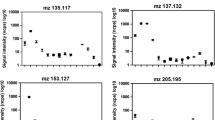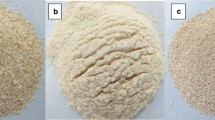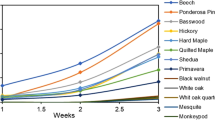Abstract
The resistance of wood against fungal decay, in short the natural durability, is one of the main criteria for defining the potential use of a wood species. Wood collections, or xylaria, offer the unique opportunity to screen many specimens and species for the latter purpose yet sample size is often limited and standardized tests are often not possible neither desired given the historical and cultural value of these specimens. Two different methods to determine the natural durability are tested and presented here, more specifically the mini-block test and chemical fingerprinting by Direct Analysis in Real-Time Time-Of-Flight Mass Spectrometry (DART TOFMS). Fungal decay by Trametes versicolor was determined for 577 mini-blocks collected from xylarium specimens and 602 mini-blocks from commercial species, not belonging to the xylarium collection, were included as a benchmark. Mass loss percentages of the different species are similar to reported values, supporting the use of the mini-block test when standardized testing is hardly feasible. Furthermore, as expected there is also a significantly negative relationship between density and the mass loss percentages from the mini-block test (r-Spearman = − 0.65***). Finally, partial least square-based prediction of recorded mass loss by using the DART TOFMS chemical fingerprints is promising (R2-adjusted = 0.40***), yet the accuracy differs between species.








Similar content being viewed by others
References
Afendi FM, Okada T, Yamazaki M, Morita A-H, Nakamura Y, Nakamura K, Ikeda S, Takhashi H, Altaf-Ul-Amin M, Darusman L, Saito K, Kanaya S (2012) KNApSAck family databases: integrated metabolite-plant species database for multifaceted plant research. Plant Cell Physiol 53:1–12
Alfredsen G, Flæte PO, Temiz A, Eikenes M, Militz H (2004) Screening of the efficacy of tall oils against wood decaying fungi. In: Proceedings IRG annual meeting, IRG/WP 04-30354, 10 pp
Amusant N, Beauchene J, Fournier M, Janin G, Thevenon M-F (2004) Decay resistance in Dicorynia guianensi Amsh.: analysis of inter-tree and intra-tree variability and relations with wood colour. Ann For Sci 61:373–380
Arango RA, Green F III, Hintz K, Lebow PK, Miller RB (2006) Natural durability of tropical and native woods against termite damage by Reticulitermes flavipes (Kollar). Int Biodeterior Biodegrad 57:146–150. https://doi.org/10.1016/j.ibiod.2006.01.007
Bamber R, Fukazawa K (1985) Sapwood and heartwood: a review. For Abstr 46:567–580
Benjamini Y, Hochberg Y (1995) Controlling the false discovery rate—a practical and powerful approach to multiple testing. J R Stat Soc 57(1):289–300. https://doi.org/10.2307/2346101
Bhat KM, Thulasidas PK, Maria Florence EJ, Jayaraman K (2005) Wood durability of home-garden teak against brown-rot and white-rot fungi. Trees 19:654–660. https://doi.org/10.1007/s00468-005-0429-0
Bravery AF (1979) A miniaturised wood-block test for the rapid evaluation of wood preservative fungicides. In: Proceedings of a special seminar held in association with the 10th annual meeting of the IRG, Peebles, Report No. 136. Swedish Wood Preservation Institute, Stockholm
Brown J, Caswell S, Williams GR (1991) Development of a Miniblock test method for the rapid evaluation of preservative performance against Basidiomycete fungi. In: Proceedings IRG annual meeting, IRG/WP 2379, 12 pp
Carey JK (1988) Some observations on miniaturised soil/block tests. In: Proceedings IRG annual meeting, IRG/WP 2316, 6 pp
Carrillo A, Foroughbachk R, Bustamante V, Wehenkel C, González H (2013) Natural durability of wood of ten native species from northeastern Mexico. For Sci Pract 15(2):160–166. https://doi.org/10.1007/s11632-013-0201-2
CEN/TS 15083-1 (2005) Durability of wood and wood-based products. Determination of the natural durability of solid wood against food-destroying fungi, test methods. Basidiomycetes. European Committee for Standardisation (CEN), Brussels
Chang BS, Wang S, Wu C, Chen P, Kuo Y (2000) Comparison of the antifungal activity of cadinane skeletal sesquiterpenoids from Taiwania (Taiwania cryptomerioides Hayata) heartwood. Holzforschung 54:241–245
Cirad (2017) Tropix 7: the main technologocial characteristics of 245 tropical wood species. Paradis S Guibal D, Gérard J, Beauchêne J, Brancheriau L, Cabantous B, Châlon I, Daigrement C, Détienne P, Fouquet D, Langbour P, Lotte S, Méjean C, Parant B, Thévenon M-F, Thibaut A, Vernay M. https://doi.org/10.18167/74726f706978
Cody RB, Laramée JA (2005) Versatile new ion source for the analysis of materials in open air under ambient conditions. Anal Chem 77(8):2297–2302
Cody RB, Dane AJ, Dawson-Andoh B, Adedipe EO, Nkansah K (2012) Rapid classification of White Oak (Quercus alba) and Northern Red Oak (Quercus rubra) by using pyrolysis direct analysis in real time (DART™) and time-of-flight mass spectrometry. J Anal Appl Pyrol 95:134–137. https://doi.org/10.1016/j.jaap.2012.01.018
De Vetter L, Stevens M, Van Acker J (2009) Fungal decay resistance and durability of organosilicon-treated wood. Int Biodeterior Biodegrad 63(2):130–134. https://doi.org/10.1016/j.ibiod.2008.08.002
Deklerck V, Finch K, Gasson P, Van den Bulcke J, Van Acker J, Beeckman H, Espinoza E (2017) Comparison of species classification models of mass spectrometry data: kernel discriminant analysis vs random forest; a case study of Afrormosia (Pericopsis elata (Harms) Meeuwen). Rapid Commun Mass Spectrosc 31(May):1582–1588. https://doi.org/10.1002/rcm.7939
Deklerck V, De Mil T, Kondjo P, Beeckman H, Van Acker J, Van den Bulcke J (2019a) Sleeping beauties in materials science: unlocking the value of xylarium specimens in search for the timbers of the future. Holzforschung 73(10):889–897. https://doi.org/10.1515/hf-2018-0269
Deklerck V, Mortier T, Goeders N, Cody RB, Waegeman W, Espinoza E, Van Acker J, Van den Bulcke J, Beeckman H (2019b) A protocol for automated timber species identification using metabolome profiling. Wood Sci Technol 53(4):953–965
Dinno A (2017) Package dunn.test
Eaton RA, Hale MD (1993) Wood: decay, pests and protection. Chapman & Hall, London
EN 113 (1996) Durability of wood and wood-based products—test method against wood destroying basidiomycetes—part 1: assessment of biocidal efficacy of wood preservatives. European Committee for Standardisation (CEN), Brussels
EN 350 (2016) Durability of wood and wood-based products. Testing and classification of the durability to biological agents of wood and wood-based materials. European Committee for Standardisation (CEN), Brussels
Esenther GR (1977) Nutritive supplement method to evaluate resistance of natural or preservative-treated wood to Subterranean termites. J Econ Entomol 70:341–346
Espinoza EO, Lancaster CA, Kreitals NM, Hata M, Cody RB, Blanchette RA (2014) Distinguishing wild from cultivated agarwood (Aquilaria spp.) using direct analysis in real time and time of-flight mass spectrometry. Rapid Commun Mass Spectrosc 28:281–289. https://doi.org/10.1002/rcm.6779
Finch K, Espinoza E, Jones FA, Cronn R (2017) Source identification of western Oregon Douglas–Fir wood cores using mass spectrometry and random forest classification. Appl Plant Sci. https://doi.org/10.3732/apps.1600158
Flæte PO, Haartveit EY (2004) NIR spectroscopy for rapid estimation of decay resistance. In: Proceedings IRG annual meeting, IRG/WP 04-20294
Gierlinger N, Schwanninger M, Hinterstoisser B, Wimmer R (2002) Rapid determination of heartwood extractives in Larix sp. by means of Fourier transform near infrared spectroscopy. J Near Infrared Spectrosc 10:203–214
Gierlinger N, Jacques D, Schwanninger M, Wimmer R, Hinterstoisser B, Pâques LE (2003) Rapid prediction of natural durability of larch heartwood using Fourier transform near-infrared spectroscopy. Can J For Res 33:1727–1736. https://doi.org/10.1139/X03-092
Gierlinger N, Jacques D, Grabner M, Wimmer R, Schwanninger M, Rozenberg P, Pâques LE (2004) Colour of larch heartwood and relationships to extractives and brown-rot decay resistance. Trees 18:102–108. https://doi.org/10.1007/s00468-003-0290-y
Hart JH, Hillis WE (1972) Inhibition of wood-rotting fungi by Ellagitannins in the heartwood of Quercus alba. Phytopathology 62:620–626
Hillis WE (1987) Heartwood and tree exudates. Springer, Berlin
Humar M, Fabčič B, Zupančič M, Pohleven F, Oven P (2008) Influence of xylem growth ring width and wood density on durability of oak heartwood. Int Biodeterior Biodegrad 62:368–371. https://doi.org/10.1016/j.ibiod.2008.03.010
Jellison J, Kelley S, Goodell B, Hui D, Ostrofsky A (2002) Differences in pH, electrical resistance, cation composition and NIR spectra of red spruce wood during early stages of brown rot. In: Proceedings IRG annual meeting, IRG/WP 02-10449
Kelley SS, Jellison J, Goodell B (2002) Use of NIR and pyrolysis-MBMS coupled with multivariate analysis for detecting the chemical changes associated with brown-rot biodegradation of spruce wood. FEMS Micrbiolgy Lett 209:107–111
Klaassen RKWM (2018) Houtvademecum. In: Klaassen HM, Zuijdwijk M (eds) (11th ed). Vakbladen.com & Smartwave, Zwolle
Kumi-Woode BG (1996) Natural decay resistance of some Ghanaian timbers and wood decay hazard potential for Ghana. Thesis, University of Ghana
Kutnik M (2013) Focus on the European standardization—towards a revision of the EN 350 natural durability standard: a different approach to the inherent resistance and performance of wood and wood-based materials. In: The proceedings IRG annual meeting, IRG 13-10811
Lancaster C, Espinoza E (2012) Analysis of select Dalbergia and trade timber using direct analysis in real time and time-of-flight mass spectrometry for CITES enforcement. Rapid Commun Mass Spectrosc 26(9):1147–1156. https://doi.org/10.1002/rcm.6215
Maniatis D, Saint André L, Temmerman M, Malhi Y, Beeckman H (2011) The potential of using xylarium wood samples for wood density calculations: a comparison of approaches for volume measurement. IForest 4(1):150–159. https://doi.org/10.3832/ifor0575-004
Mann HB, Whitney DR (1947) On a test of whether one of two random variables is stochastically larger than the other. Ann Math Stat 18(50):60
Mbambo B, Odhav B, Mohanlall V (2012) Antifungal activity of stigmasterol, sitosterol and ergosterol from Bulbine natalensis Baker (Asphodelaceae). J Med Plants Res 6(38):5135–5141. https://doi.org/10.5897/JMPR12.151
McClure PJ, Chavarria GD, Espinoza E (2015) Metabolic chemotypes of CITES protected Dalbergia timbers from Africa, Madagascar, and Asia. Rapid Commun Mass Spectrosc 29(9):783–788. https://doi.org/10.1002/rcm.7163
Morimoto M, Fukumoto H, Hiratani M, Chavasiri W, Komai K (2006) Insect antifeedants, pterocarpans and pterocarpol, in heartwood of Pterocarpus macrocarpus Kruz. Biosci Biotechnol Biochem 70(8):1864–1868. https://doi.org/10.1271/bbb.60017
Niamké FB, Amusant N, Charpentier J-P, Chaix G, Baissac Y, Boutahar N, Kati-Coulibaly AA, Kati-Coulibaly S, Jay-Allemand C (2011) Relationships between biochemical attributes (non-structural carbohydrates and phenolics) and natural durability against fungi in dry teak wood (Tectona grandis L. f.). Ann For Sci 68:201–211
Nzokou P, Wehner K, Kamdem DP (2005) Natural durability of eight tropical hardwoods species from Africa. In: Proceedings IRG annual meeting, IRG/WP 05-10563
Palanti S, Feci E, Predieri G, Francesca V (2012) Copper complexes grafted to amino-functionalized silical gel as wood preservatives against fungal decay: mini-blocks and standard test. BioResources 7(4):5611–5621. https://doi.org/10.15376/biores.7.4.5611-5621
Panshin A, de Zeeuw C (1980) Textbook of wood technology, 4th edn. McGraw-Hill, New York
Peralta RCG, Menezes EB, Carvalho AG, de Aguiar-Menezes EL (2004) Wood consumption rates of forest species by subterranean termites (isoptera) under field conditions. Soc Investig Florestais 28:283–289
Petrič M, Pohleven F, Humar M, Kolman U (1998) Fungicidal efficacy of some dimethyldithiocarbamates, dymethylaminopropionitrile and some salts of S- substituted thioglycolic acid. In: Proceedings IRG annual meeting, IRG/WP 98-30180
Pilgård A, Brischke C, Meyer L (2013) Relevance of natural pre-weathering for laboratory decay tests with native, modified, and preservative-treated wood. In: Proceedings IRG annual meeting, IRG/WP 13-20522
Plaschkies K, Jacobs K, Scheiding W, Melcher E (2014) Investigations on natural durability of important European wood species against wood decay fungi. Part 1: laboratory tests. Int Biodeterior Biodegrad 90:52–56. https://doi.org/10.1016/j.ibiod.2014.01.016
Pohleven F, Petrič M, Zupin J (2000) Effect of mini-block test conditions on activity of Coniophora puteana. In: Proceedings IRG annual meeting, IRG/WP 00-20184
Rana R, Langenfield-Heyser R, Finkeldey R, Polle A (2010) Characterisation of wood and lignin of five tropical timber wood species of the family of Dipterocarpaceae. Wood Sci Technol 44:225–242. https://doi.org/10.1007/s00226-009-0281-2
Rosenqvist M, Karlsson MI (1999) Nära infraröd spektroskopi för analys av extraktivämnen i furu (Near infrared spectroscopy for analysis of extractive substances in pine). Trätek, Report I 9908032, The Swedish Institute for Wood Technology Research, Stockholm, Sweden
RStudio Team (2016) RStudio: integrated development for R. RStudio, Inc., Boston, MA. http://www.rstudio.com/
Saha Tchinda JB, Ndikontar MK, Fouda Belinga AD, Mounguengui S, Njankouo JM, Durmaçay S, Gerardin P (2018) Inhibition of fungi with wood extractives and natural durability of five Cameroonian wood species. Ind Crop Prod 123:183–191. https://doi.org/10.1016/j.indcrop.2018.06.078
Sailer M, Rapp AO, Peek R-D (1998) Biological resistance of wood treated with waterbased resins and drying oils in a mini-block test. In: Proceedings IRG annual meeting, IRG/WP 98-40107
Scheffer TC, Cowling E (1966) Natural resistance of wood to microbial deterioration. Annu Rev Phytopathol 4:147–170
Schmidt O (2006) Wood and tree fungi: biology, damage, protection, and use. Springer, Berlin
Schultz TP, Nicholas DD (2000) Naturally durable heartwood: evidence for a proposed dual defensive function of the extractives. Phytochemistry 54:47–52
Schwanninger M, Hinterstoisser B, Gradinger C, Messner K, Fackler K (2004) Examination of spruce wood biodegraded by Ceriporiopsis subvermispora using near and mid infrared spectroscopy. J Near Infrared Spectrosc 409:397–409
Sehlstedt-Persson M, Karlsson O (2010) Natural durability and phenolic content in dried Scots pine heartwood. BioResources 5(2):1126–1142
Shapiro SS, Wilk M (1965) An analysis of variance test for normality (complete samples). Biometrika 52(3–4):591–611
Shinbo Y, Nakamura Y, Altaf-Ul-Amin M, Asahi H, Kurokawa H, Arita M, Saito K (2006) KNApSAcK: a comprehensive species-metabolite relationship database. In: Nagata T, Lörz H, Widholm JM (eds) Plant metabolomics. Springer, Heidelberg, pp 165–181
Snedecor GW, Cochran WG (1989) Statistical methods, 8th edn. Iowa State University Press, Iowa
Sundararaj R, Shanbhag RR, Nagaveni HC, Vijayalakshmi G (2015) Natural durability of timbers under Indian environmental conditions—an overview. Int Biodeterior Biodegrad 103:196–214. https://doi.org/10.1016/j.ibiod.2015.04.026
Taylor AM, Gartner BL, Morrell JJ (2002) Heartwood formation and natural durability—a review. Wood Fiber Sci 34(4):587–611
Van Acker J, Stevens M, Carey J, Sierra-Alvarez R, Militz H, Le Bayon I, Kleist G, Peek RD (2003) Biological durability of wood in relation to end-use. Holz Roh Werkst 61(1):35–45. https://doi.org/10.1007/s00107-002-0351-8
Van Acker J, De Windt I, Li W, Van den Bulcke J (2014) Critical parameters on moisture dynamics in relation to time of wetness as factor in service life prediction. In: Proceedings IRG annual meeting, IRG/WP 14-20555
Verma P, Mai C, Krause A, Militz H (2005) Studies on the resistance of DMDHEU treated wood against white-rot and brown-rot fungi. In: Proceedings IRG annual meeting, IRG/WP 05-10566
Wang Q, Zhou B, Yang S (2004) Progress on antioxidant activation and extracting technology of flavonoids. Chem Prod Technol 5(11):29–33
Wehrens R, Hovde K, Hiemstra P (2018) Package pls
Wickham H, Chang W (2016) Package ggplot2, Create elegant data visualisations using the grammer of graphics
Wong AHH, Kim YS, Singh AP, Ling WC (2005) Natural durability of tropical species—variations and prospects. In: Proceedings IRG annual meeting, IRG/WP 05-10568
Acknowledgements
The authors would like to thank Stijn Willen (UGent-Woodlab) for his help with the mini-block preparation and Erin McClure-Price (US Fish and Wildlife Forensic Laboratory) for her help with the DART TOFMS sample preparation. Funding: This research was conducted under the HerbaXylaRedd BELSPO-Project (Brain.be—code: BR/143/A3/HERBAXYLAREDD) and FWO—SB (Fonds Wetenschappelijk Onderzoek, code: 1S53417N). The funding sources had no other involvement besides financial support. The findings and conclusions in the article are those of the authors and do not necessarily represent the views of the U.S. Fish and Wildlife Service.
Author information
Authors and Affiliations
Corresponding author
Ethics declarations
Conflict of interest
On behalf of all authors, the corresponding author states that there is no conflict of interest.
Additional information
Publisher's Note
Springer Nature remains neutral with regard to jurisdictional claims in published maps and institutional affiliations.
Electronic supplementary material
Below is the link to the electronic supplementary material.
Rights and permissions
About this article
Cite this article
Deklerck, V., De Ligne, L., Espinoza, E. et al. Assessing the natural durability of xylarium specimens: mini-block testing and chemical fingerprinting for small-sized samples. Wood Sci Technol 54, 981–1000 (2020). https://doi.org/10.1007/s00226-020-01186-1
Received:
Published:
Issue Date:
DOI: https://doi.org/10.1007/s00226-020-01186-1




